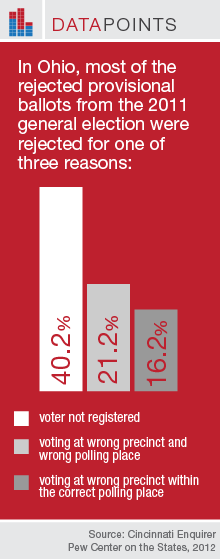Provisional Ballots in Ohio
Return to Election Data Dispatches.
An analysis by the Cincinnati Enquirer found that the number of provisional ballots cast in Ohio was greater in the 2011 general election than in the 2009 general election. Provisional ballot use increased in 72 counties, remained the same in seven counties, and decreased in nine counties. While the number of overall provisional ballots grew in 2011, the proportion of provisional ballots counted decreased. The study found that most of the provisional ballots were rejected for one of three reasons:
- 40.2 percent were rejected because the voter was not listed as registered to vote in Ohio;
- 21.2 percent were rejected for voting at the wrong precinct and wrong polling place; and
- 16.2 percent were rejected for voting at the wrong precinct within the correct polling place (see below).
The analysis also highlights important county-level differences in how provisional ballots are administered and counted. The percent of submitted provisional ballots that were counted in 2011 ranged from 96.1 percent in Fayette County to only 60.6 percent in Vinton County. The reason for ballots being rejected also varied between counties. For example, 50 percent of Montgomery County’s rejected ballots were not accepted because the voter’s polling place served multiple precincts and, though the voter voted at the correct polling place, they cast a ballot for the wrong precinct. By contrast, almost half of the counties did not reject any ballots for this reason.











